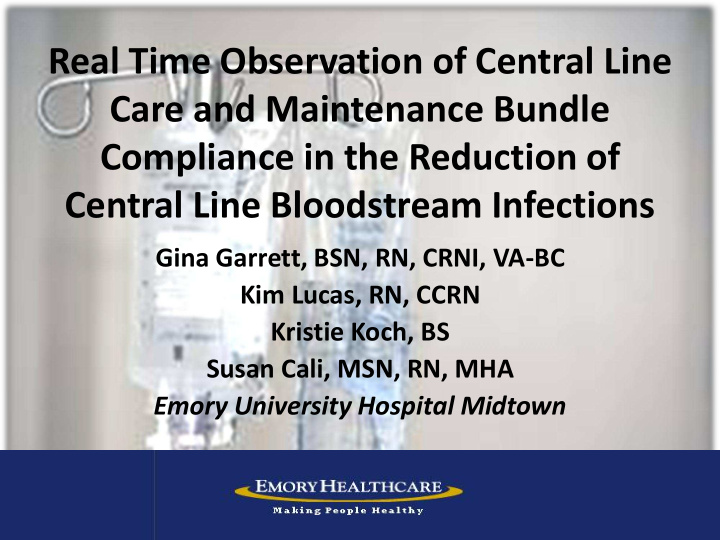



Real Time Observation of Central Line Care and Maintenance Bundle Compliance in the Reduction of Central Line Bloodstream Infections Gina Garrett, BSN, RN, CRNI, VA-BC Kim Lucas, RN, CCRN Kristie Koch, BS Susan Cali, MSN, RN, MHA Emory University Hospital Midtown
Purpose Standardize and align nursing practice with evidence based guidelines to reduce central line bloodstream infections at Emory University Hospital Midtown
Aim Reduction of Central Line Bloodstream Infections
Background • EUHM CLABSI were above NHSN mean • CLABSI are now reported to CMS via NHSN • Nursing practice for care of central lines varied throughout the hospital • Pay for Performance Initiative by CMS • Cost $16,550 to $45,000 estimated per CLABSI • TJC patient safety
Baseline Data • There had been 68 CLABSI from September 2012 through March 2011 • Compliance rate for care and Maintenance bundle was 56.6% in April of 2011 • Poor compliance with all bundle components • Initial bundle contained 12 components
Practice Change • Reviewed Evidenced Based Guidelines • Reduced number of components of Care and Maintenance Bundle from 12 to 5 to better fit staff work flow • PDSA Cycle • Developed electronic data tool – Sixteen observations per month
Care and Maintenance Bundle 1. Central line dressing dated 2. Central line dressing changed in last 7 days 3. Transparent dressing 4. IV tubing dated 5. Biopatch present and placed correctly
Central Line Care and Maintenance Bundle Multi-lumen Catheters, PICC, Implanted Ports, Hemodialysis/Apheresis Catheters, Tunneled Catheters HAND HYGIENE Before and after all patient contact, use of gloves and manipulation of central lines DAILY TASK Site assessment and documentation Central Line Necessity / removal of central line if no longer needed Scrub the Hub with alcohol prior to each access for at least 15 seconds/let dry Check each catheter lumen for patency and document* Flush each catheter lumen before and after any infusions or medication administration* WEEKLY TASK (every seven days)** Change central line dressing/needleless connector/securement device Use Chlorhexidine (CHG) patch on all central lines IV TUBING AND FLUIDS Every 12 Hours Every 24 Hours Every 48 Hours Every 96 Hours Change and label Change and label all Change and label Change and label Propofol tubing IV fluid bags Epidural/PCA tubing primary/secondary tubing Change and label TPN tubing * Patency of Hemodialysis/apheresis catheters should not be established except if the catheter has a 3 rd (middle) lumen. Patency and flushed per protocol is required for the 3 rd (middle) lumen. * Central line dressing will be changed if not intact (loose), wet, and/or soiled. ** Needleless connectors will be changed with each dressing and PRN visible blood in connector. ** Securement device (if present) will be changed with each dressing. ** CHG patch will be changed with each new dressing and/or if patch becomes 50% saturated. 8/2011 v10 EHC
Results • Decrease in CLABSI for FY 2012 – 68 CLABSI YTD FY 2011 • Rate 1.04 per 1000 patient days – 21 CLABSI YTD FY 2012 • Rate 0.33 per 1000 patient days • Increase in bundle compliance – Increased compliance to 84.95% with 13 units reporting • Decrease in bundle components • Developed root cause analysis process
Challenges/Barriers • Lack of buy in from nursing leadership and staff • Multiple competing initiatives • Observation basis • Lack of knowledge regarding impact on patients and organization from nursing leadership and staff • Developing unit specific processes for data collection and care of patient’s with central lines
Next Steps • Focus on issues related to non-compliance • RCA on every CLABSI • CLABSI Team Meetings including leadership, champions and medical staff twice a month • Feedback of CLABSI rates and audits on unit level
Questions ?
Recommend
More recommend